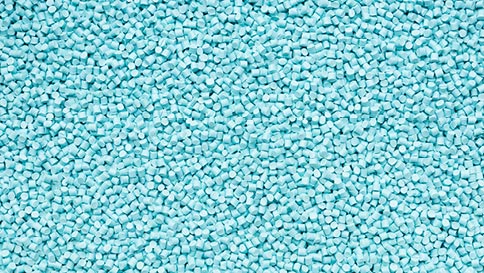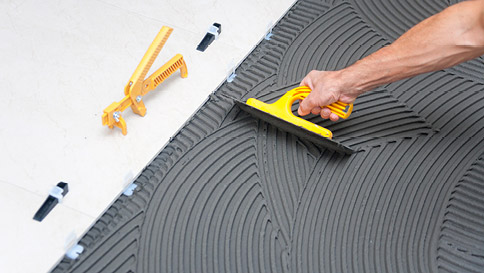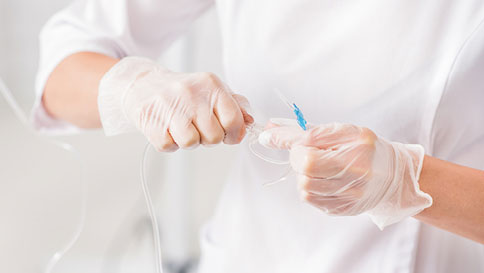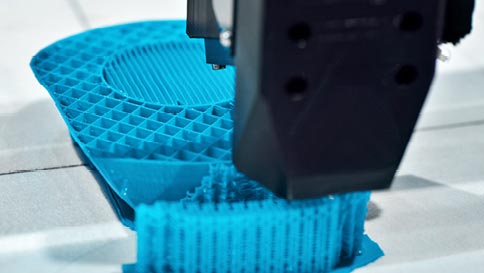What is TPE?
Due to their design and manufacturing flexibility, thermoplastic elastomers (TPEs) are among the most versatile plastics on the market. TPEs combine the processing advantages of thermoplastics with the performance properties of elastomers. As a result, they are relatively easy to process using thermoplastic methods such as extrusion and injection molding. Time intensive rubber processing methods, especially vulcanization, are not required.
The nature of their molecular structure gives a TPE high elastic properties. All TPEs are composed of crystalline and amorphous domains. These can be physical blends or alloys of crystalline and amorphous polymers, or they can be block copolymers, which are chemical mixtures of blocks of crystalline and amorphous domains in the polymer chain.
The hard blocks are responsible for the plastic properties of the final product in the case of TPEs and blends, including easy processing and temperature resistance and material properties such as tear and tensile strength or chemical resistance. Adhesion is also determined by these properties. The soft blocks are responsible for the elastomeric or elastic properties. They determine material properties such as hardness and flexibility as well as the extent of permanent deformation.
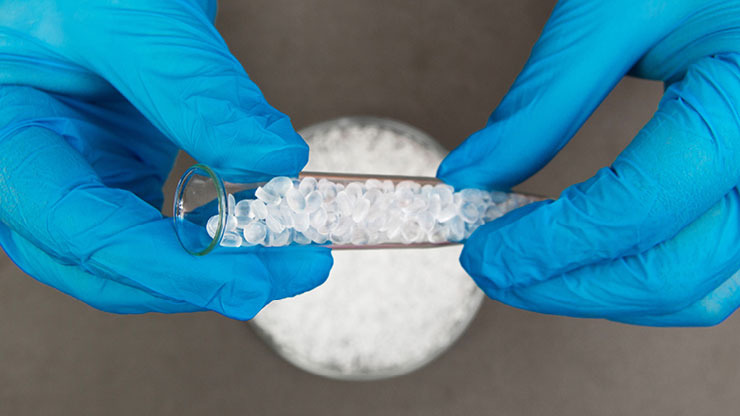
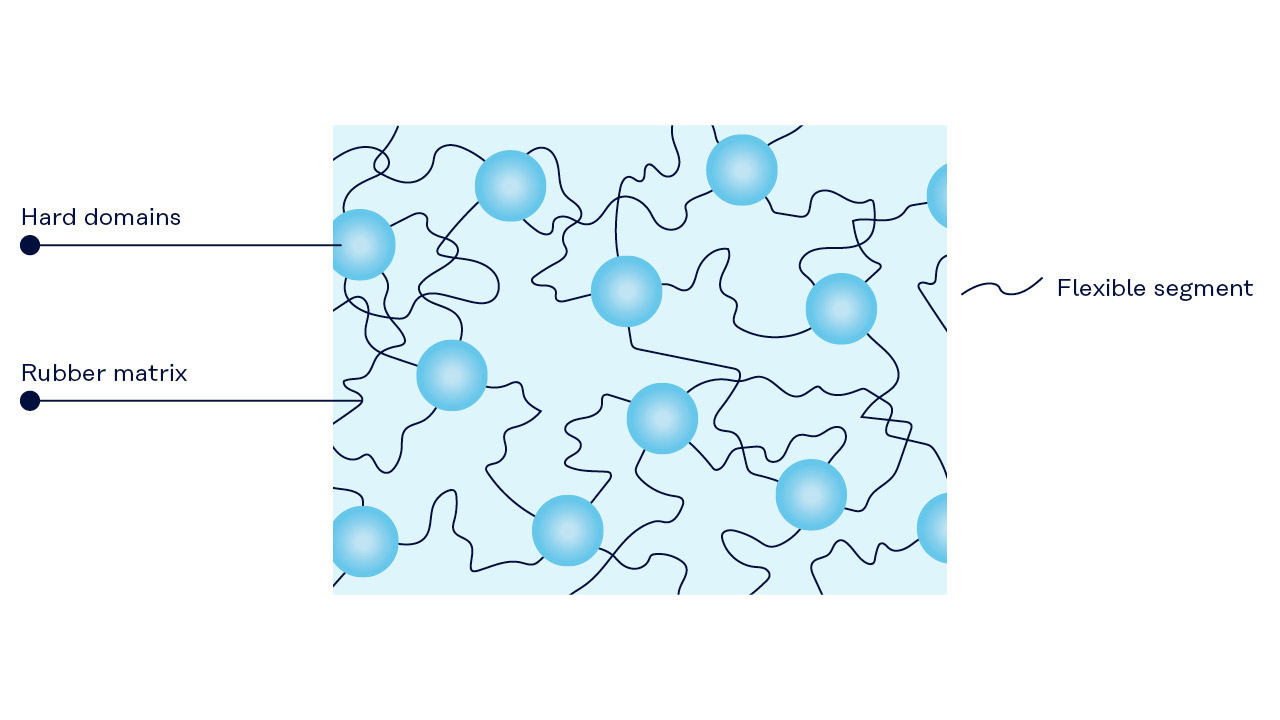
Thermoplastic elastomers: A quick definition
Thermosets, thermoplastics and elastomers are common polymers. A quick explanation should clarify the affiliation of thermoplastic elastomers.
Thermosets: Polyurethane and epoxy are common thermosets. These materials are characterized by the fact that they are not soluble and cannot be melted. Their strength is owed to a crosslinked network formed by a reactive oligomer or resin reacting with a crosslinking agent under heat and pressure.
Thermoplastics: Thermoplastics are polymers that can be easily melted and formed. They are melted by heat and harden when cooled. Well-known representatives are nylon, polyester and polyolefin. These materials do not contain a crosslinked network.
Elastomers: Elastomers are natural or synthetic polymers having elastic properties. They can deform elastically under tensile and compressive stress, but then return to their original, undeformed shape. A best-known elastomer is natural rubber and silicone rubber.
Thermoplastic Elastomers: TPEs combine the properties of thermoplastics and elastomers: They are materials that process like plastic but share the superior performance characteristics of rubber.
Content
- Thermoplastic elastomers: A quick definition
- Advantages / disadvantages
- Types of TPEs
- Properties of TPEs
- TPE processing
- Applications
- Regulatory
- Kuraray’s TPEs
- Contact
Advantages
- High design freedom
- Easy thermoplastic processing by injection molding and extrusion
- Wide processing window
- Multi-component processing possible
- Shorter production cycles and higher productivity
- Lower finished parts costs
- Less energy consumption
- TPE characteristics: Fully recyclable
- Good coloring
- Low permeability
- Outstanding thermal properties and material stability
- Wide possible range of hardness: Shore OO, Score C, Shore A and Shore D
- Excellent electrical insulation properties
- Wide range of applications
Disadvantages
- Shear sensitive
- Limited use in high-temperature applications
- Higher raw material per kg costs compared to thermoset
- Low resistance to aromatics
- Shrinkage
Types of TPEs
SBC / TPE-S / TPS
Styrene block copolymers (SBCs) are the largest and probably also the most versatile group among TPE materials. Composed of hard styrene mid-blocks and soft end-blocks from raw materials such as butadiene or isoprene, they have a unique multiphase structure. In more general terms, the structure of the multiphase compounds can be described as a poly(styrene-b-elastomer-b-styrene) structure. It is obtained through block copolymerization.
SBCs are widely used because they blend well with many materials, including additives, resins and fillers. They are characterized by high elasticity, tensile strength and abrasion resistance. The products are colorless and are available in a wide range of hardness. They can be engineered to function over a broad temperature range and show varying degrees of tackiness, as well as shock absorption.
The exact properties of such a thermoplastic elastomer vary depending on the chemical structure of the elastomer block. This allows for a great level of customization.
The following main types are available:
- SEP: styrene-ethylene-propylene block copolymer
- SEPS: styrene-ethylene-propylene-styrene block copolymer
- SEEPS: styrene-ethylene-ethylene-propylene-styrene block copolymer
- S*EEPS*-V: S*-ethylene-ethylene-propylene-S* block copolymer (S*: crosslinkable hard block)
- SBS: styrene-butadiene-styrene block copolymer
- SEBS: styrene-ethylene-butylene-styrene block copolymer
- SIS: styrene-isoprene-styrene block copolymer
In addition, there are unique vinyl-bond rich TPEs, which can replace PVC and eliminate the need to use plasticizers:
Kuraray offers SEPTON™ and HYBRAR™ styrenic block copolymers that are applicable to a broad range of fields, such as TPE compounds, polymer modification, adhesives, PVC replacement, damping applications, and more.
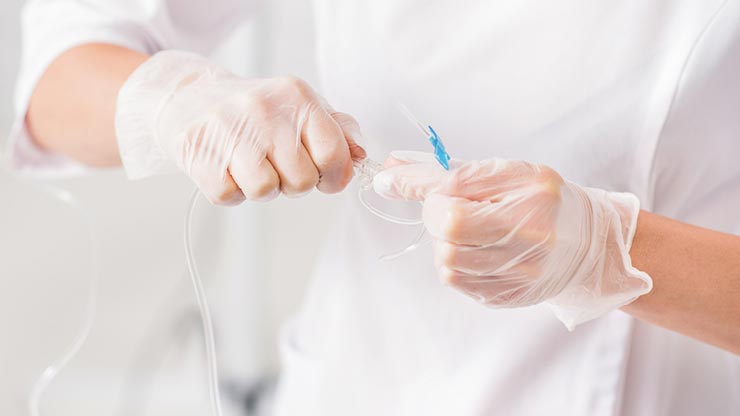
TPO / TPE-O
Thermoplastic polyolefins (TPOs) are blends of uncrosslinked EPDM rubber and polyolefins. They are characterized by high chemical resistance and strength and by low density. The materials can be easily processed by extrusion and injection molding.
The products are very light and can be used extremely flexibly. They are used in applications that require a high level of plastic durability and resistance to wear and tear, which standard copolymers do not meet. These include, for example, dashboards for motor vehicles.
TPU / TPE-U
Thermoplastic polyurethanes (TPUs) are a group of plastics formed by the polyaddition reaction of diols or polyols with polyisocyanates. A characteristic feature of polyurethanes is the urethane group. The properties of TPUs can be varied over a wide range. Depending on the degree of crosslinking and/or the isocyanate or OH component used, they can be used as elastomers, thermoplastics or rubber substitutes.
Typical properties of TPUs include high extensibility and tensile strength. They have excellent abrasion resistance and outstanding mechanical properties. They show good resistance to oxygen and ozone.
TPC / TPE-E
Thermoplastic polyester elastomers (TPCs) are linear block copolymers with a crystalline and an amorphous segment, which give the TPE material elasticity and make it easy to process. Thanks to the rigidity of the crystalline segment, TPCs are impact resistant over a wide temperature range. Their heat resistance, chemical resistance and aging resistance are high.
In addition to the characteristics described, TPCs also exhibit good electrical insulation properties. Because of their fatigue resistance and tear strength, they are also used in the automotive sector and industry for hoses, cables, bellows, etc.
COPA / PEBA / TPE-A / TPA
Polyamide block copolymers (TPAs) are thermoplastic elastomers based on polyester-amide, polyether-ester-amide or polyether-amide block copolymers. Their properties are highly dependent on the type of polyether and polyamide block and the number and length of the blocks.
TPAs can be used in demanding applications where high temperature and oil resistance are required. They also have a certain flexibility at low temperatures and are abrasion, wear and impact resistant. Their weatherability and chemical resistance is also excellent.
TPV / TPE-V / EA
Thermoplastic vulcanizates (TPVs) are compounds of polypropylene and EPDM rubber that are dynamically vulcanized during compounding. These plastics offer rubber-like properties combined with the easy and cost-effective processability of thermoplastics.
TPVs are increasingly replacing conventional thermoset vulcanized rubber. Because of their high temperature resistance, they are increasingly being used in applications that require high heat resistance of up to 130 degrees Celsius. Since they also have good chemical and oil resistance, the engine compartment of vehicles is also a field of application for these materials.
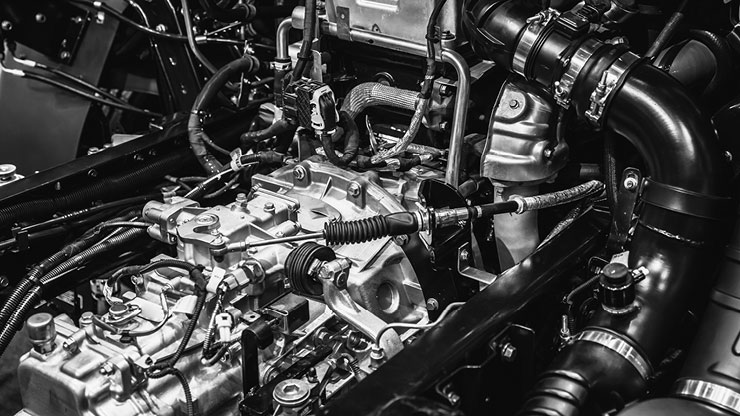
Soft-PVC (TPVC)
Polyvinyl chloride (PVC) is a widely used polymer for plastics. PVC is produced by chain polymerization from vinyl chloride. The amorphous thermoplastic is brittle and hard. By adding plasticizers, it becomes processable and is therefore suitable for diverse applications. The wide range of applications extends from the construction industry to flooring and insulation.
PVC can be divided into soft and rigid PVC. Plasticized PVC has a high concentration of primary and polymer plasticizers. Plasticizers are used in production to make PVC flexible. However, their heavy use is associated with considerable disadvantages because, on the one hand, they impair the durability of products made of flexible PVC and limit their recyclability. On the other hand, plasticizers are also considered hazardous to health, as they can leach out of the material and enter the environment and food.
Acrylic
Acrylic is the collective term for chemical substances that have an acrylic group, such as acrylic acid esters and for polymers of these substances. The acrylic group is the basis for chemical crosslinking. Acrylates owe their name to the typically pungent odor of acrylic acid.
Bio-based TPEs
Bio-based TPEs are those products in which at least part of the polymer or monomer consists of material produced from renewable raw materials, for example sugar cane or corn. The remaining portion of the polymers may consist of carbon from fossil sources. The production of customized, 100 percent bio-based materials such as the thermoplastics polyhydroxyalkanoates (PHA) and polysaccharides still presents difficulties.
The synthesis of bio-based TPEs is mostly based on biological and biochemical processes. It should be noted that the term “bio-based” does not necessarily mean “biodegradable”. Bio-based TPEs can be biodegradable, but often this is not the case.
Kuraray offers a unique bio-based TPE called SEPTON™ BIO-series, a family of hydrogenated styrene farnesene copolymers (HSFCs) made from sugar cane.

Properties of TPEs
Hardness
The hardness of the material is an important selection criterion for a thermoplastic elastomer. The characteristic value for the hardness of a TPE is usually the Shore value, which is determined with the aid of a Shore durometer. This instrument measures the depth of a depression in the material created by a given force on a standardized indenter.
The ISO 7619-1 standard recognizes twelve different durometer scales using different spring forces and indenters. The two most commonly used scales for measuring the material hardness of a TPE are Shore A (blunt indenter, moderate spring force) and Shore D (sharp indenter, stronger spring force). Shore C represents a middle ground between Shore A and Shore D. For super-soft materials such as the SEPTON™ J-series, there is Shore OO. However, other durometer scales are also used.
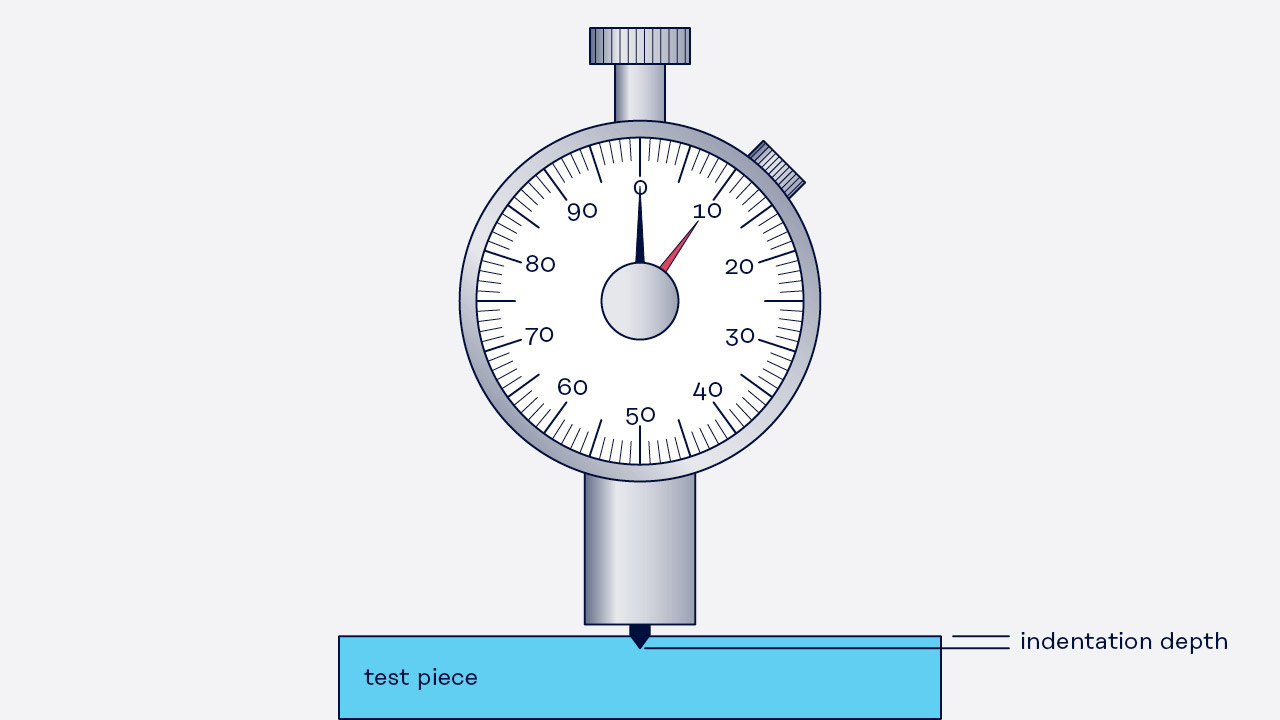
Temperature resistance
The various applications of thermoplastic elastomers require different temperature resistances of the material. The duration and type of stress, as well as the shape of the parts, all affect the requirements for maximum temperature resistance.
An extreme example of high heat resistance requirements are underhood components of cars and trucks. TPEs such as SEPTON™ V-series can here replace natural rubber for hoses, which also results in less waste. Thanks to injection molding technology, they also enable shorter cycle times in the production of grommets. Crosslinking, as with rubber, is not required.
Tensile properties
The elongation properties of TPEs are determined using various test methods.
To determine the breaking strength of a thermoplastic elastomer, it is stretched until it breaks. The tensile at break is determined in tests on standardized test specimens and is usually given in megapascals (MPa). Elastomers with high breaking strength do not break as easily as those with lower values when stretched.
In applications, a thermoplastic elastomer must often also be resistant to tearing. To determine an elastomer’s tear strength, it is subjected to a test procedure similar to a breaking strength test, except that a notched test bar is used. The units of measurement commonly used are psi (pounds per square inch) or kN/m (kilonewtons per meter).
Tensile modulus is a material parameter that describes the proportional relationship between stress and strain when a solid body deforms in linear elastic behavior. In this strain test, resistance to strain is measured over a range of strain points. The measure of the tensile strength of an elastomer is given as a percentage of its original length.
Another important parameter is the elongation at break. It indicates how far the elastomer can be stretched before it breaks and is given as a percentage of the original length. In the case of soft elastomers, this value can be over 1,000 percent.
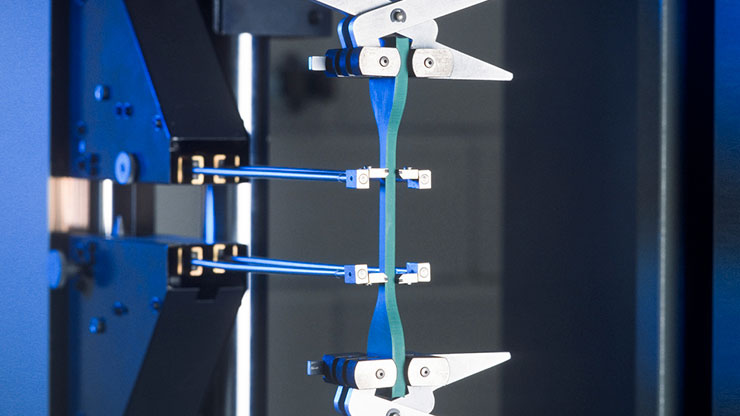
Compression set
The compression set of a TPE material is also of great importance. It is a measure of how a thermoplastic elastomer behaves under prolonged, constant compression and subsequent release. Compression set is expressed as the percentage of deflection by which a sample of an elastomer does not return to its original thickness after release of a compressive load.
The compression set is measured according to DIN 53 517 or ISO 815 or ASTM D 395 at constant deformation. To determine this quantity, a cylindrical test specimen is compressed by a certain percentage and stored for a certain time at a certain temperature. A value of zero percent means that the body has fully regained its original thickness, which is impossible in reality. 100 percent compression set means that the body has been fully deformed and shows no recovery.
Permanent deformation is an important parameter, especially for the use of seals made of elastomers. Thus, materials with a low compression set are more suitable for sealing applications.
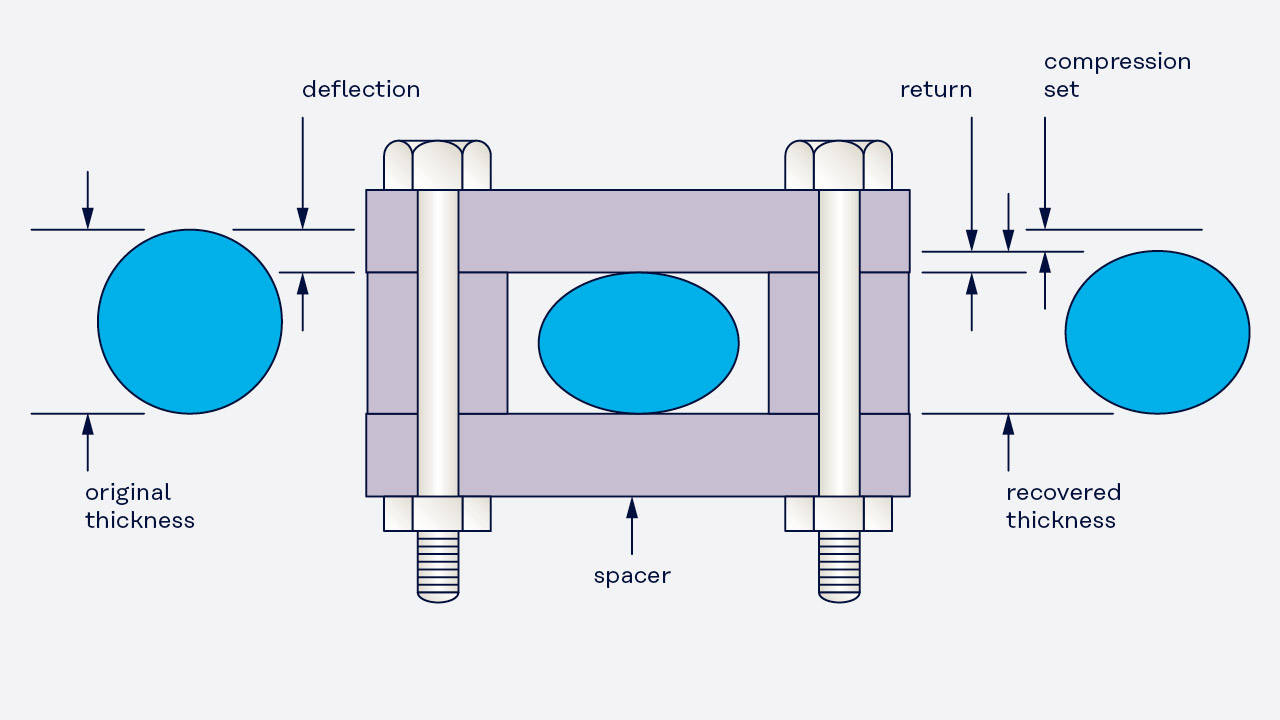
Shrinkage
Molded parts made of TPE material shrink during cooling. Although the shrinkage is usually only in the micro range, it can affect the molding and removal process as well as the appearance and subsequent exact fit of the molded part. Uneven shrinkage is particularly problematic. Shrinkage therefore deserves special attention and must be considered in mold design and process flow. Since polymers differ in their elastomeric and shrinkage properties, it is advisable for processors to obtain information about the materials from TPE manufacturers.
Safety
Thermoplastic elastomers are subjected to rigorous testing and must comply with a number of safety and regulatory standards. The exact requirements differ depending on the application of the material.
An example for particularly safe TPEs are certain grades from Kuraray that can be used for food contact and medical purposes. Some of Kuraray’s TPEs are compliant with food contact FDA and EU No.10/2011.
Products made from medical-grade TPEs can be sterilized using various processes and contain only a very low proportion of extractable substances. The biocompatibility of Kuraray’s medical-grade TPEs is studied according to ISO 10993, including ISO 10993-4 (hemolysis), -5 (cytotoxicity), -10 (skin sensitization, and -11 (pyrogen). Kuraray’s medical-grade TPEs further comply with USP <88> Class VI requirements and have been assigned to FDA Drug master file.
Other properties
Depending on the application, other properties of TPEs must be factored in the material choice. These include chemical resistance, UV stability and electrical properties, among other things.
TPE processing
Injection molding
Injection molding is by far the most important technique for processing TPE material. The main reason for this is the high productivity of injection molding and the clean, residue-free processing.
In injection molding, the molten plastic is injected into a mold, making the final product an exact copy of the mold. The behavior of TPEs in this process corresponds to that of other thermoplastics in the hot runner. The co- and insert-injection processes are equally suitable for this application. Injection molding is mainly used to produce solid parts, such as tools or components, which can be produced in high volumes and with great precision.
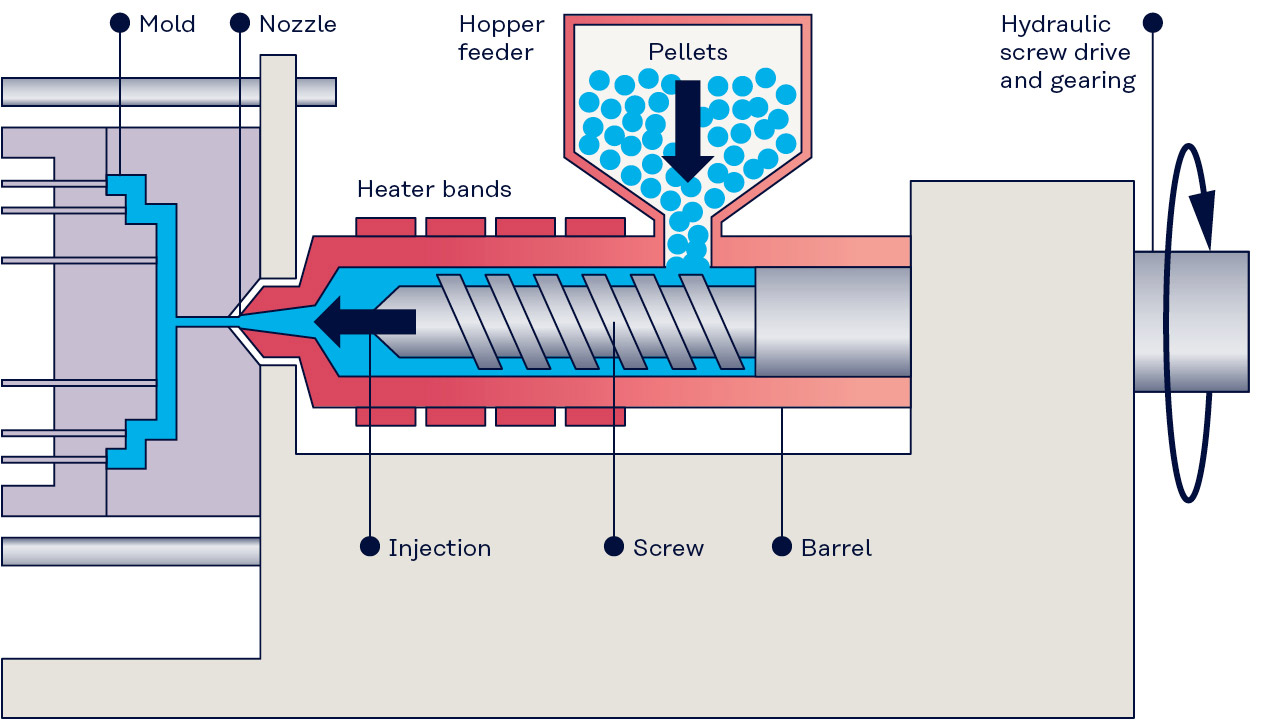
Extrusion
Extrusion is one of the most popular processes for manufacturing tubes, profiles, etc. from thermoplastic elastomers. In this continuous process, the material is shaped by forcing it through a die whose cross-sectional profile the material takes.
In extrusion, TPE pellets are fed into the extruder’s hopper are then heated and melted by a spiral screw rotating in a heated barrel. The screw conveys the molten plastic through a die to create continuous lengths of molds with the same profile, which are then cooled. Unlike injection molding, extrusion usually yields a semi-finished or intermediate product that must be further processed. This process can be used to produce very complex cross-sections with a very good surface finish and a high degree of design freedom.
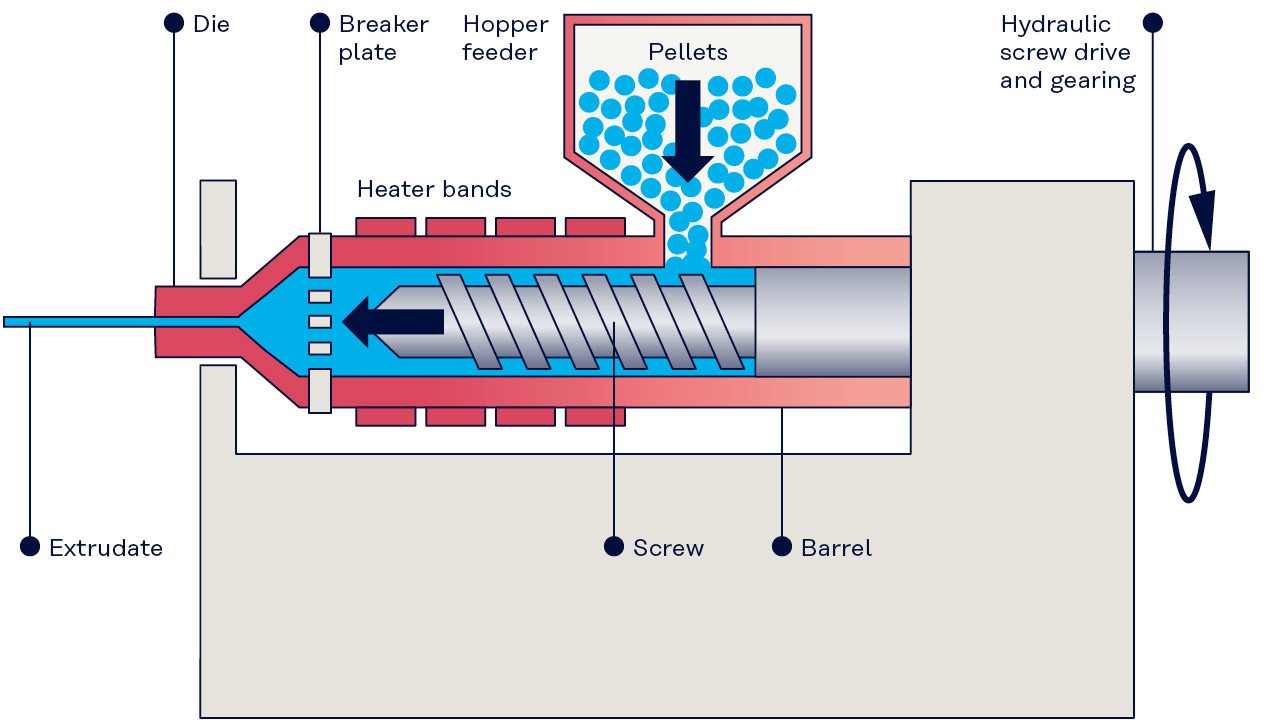
Extrusion blow molding
Another important process for shaping profiles is TPE extrusion. In extrusion, molten plastic is extruded into a mold or die. Air is then blown into the mold or tool to create the desired shape.
The dominant technology here is the single-screw extruder. However, other extruders, such as triple-screw extruders, are also used. Extrusion is used to produce even complex hollow parts such as bottles and containers. In addition to the production of profiles, extrusion is also used for sheets, pipes and other shapes.
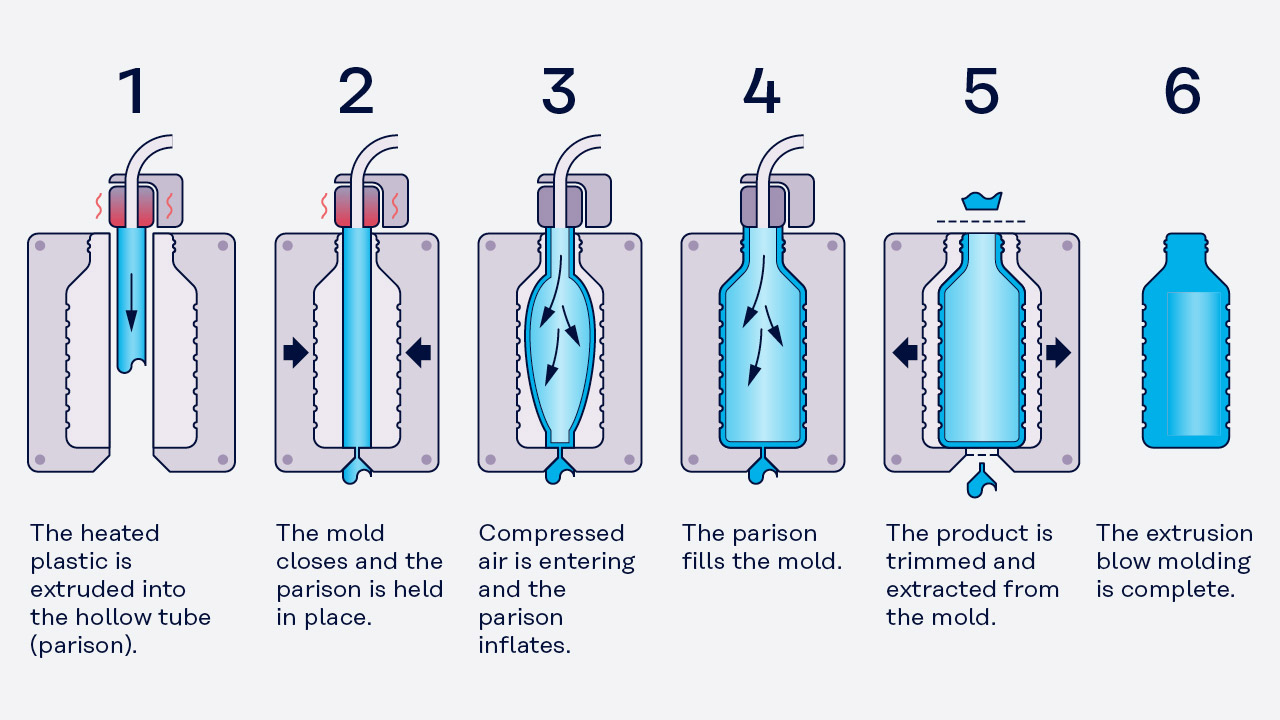
Other thermoplastic elastomer processing methods
In addition to the injection molding, extrusion and extrusion blow molding methods described above, other methods are also used for processing TPEs – although in some cases to a lesser extent. These include two component (2k) processing, melt calendering, thermoforming, hot welding and compression molding.
3D printing
Another area of application for TPE material is now 3D printing, for which materials with rubber-like properties were out of the question for a long time. Flexible TPE filaments are used here to produce flexible or customizable parts, such as smartphone covers. Thermoplastic polyurethane (TPU) is the most commonly used material for 3D printing. On the other hand, for specialized applications such as the processing of PLA, acrylonitrile butadiene styrene (ABS) and polycarbonate (PC), the TPS from Kuraray are particularly well-suited.
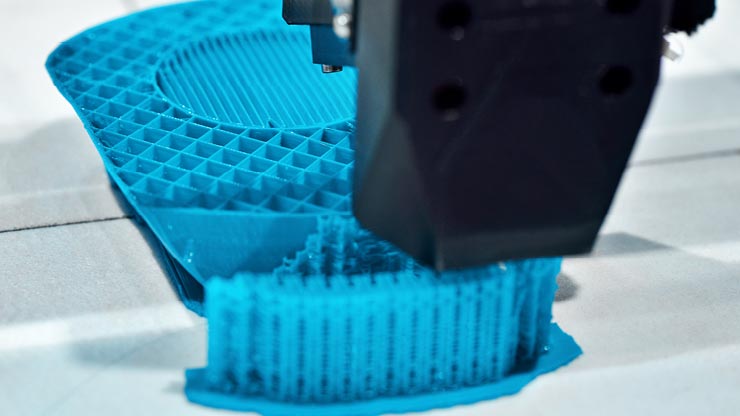
Applications
TPEs are suitable as materials for applications where a flexible or elastomeric material is required. Compared with conventional thermoset rubbers and plasticized thermoplastics, they offer advantages in terms of cost, quality and safety, as well as toxic properties. Due to their versatile mechanical properties and different processing technologies, the range of applications for TPEs is extremely broad.
Regulatory
FDA
The Food and Drug Administration (FDA) imposes strict requirements on foods produced in or imported to the United States. The food industry uses a wide variety of plastics that come into contact with food. These plastics must be compliant with FDA requirements.
USP
Plastics used in pharmaceuticals and medical devices are divided into six biocompatibility classes by the United States Pharmacopeia (USP).
EU Directive / Regulatory
Various EU regulations and directives address requirements for plastics, such as Directive (EU) 2019/1904 on single-use plastic articles. Another example is EU Directive 93/42/EEC. It contains specific requirements for medical devices in terms of safety, quality and suitability, including plastics used in medical technology.
ISO 10993
ISO 10993 is a series of ISO standards for the biological evaluation of medical devices. It is particularly relevant for medical device manufacturers and testing laboratories. The aim of the standard is to evaluate the biological assessment with regard to the compatibility of the materials used with the body. This means that not only products but also component materials for the manufacture of medical devices are tested, including medical-grade TPEs.
ASTM tests
ASTM International is an international standardization organization based in the USA that publishes technical standards for goods and services. The use of ASTM standards is voluntary except in the publicly funded sector in the USA. Despite being voluntary, many manufacturers subject their thermoplastic elastomers and other products to ASTM testing, as this is in their own interest to ensure comparability and allow customers to better understand the products.
Kuraray’s TPEs
SEPTON™ (HSBC)
SEPTON™ is a series of styrenic thermoplastic elastomers developed by Kuraray. The Hydrogenated Styrenic Block Copolymers (HSBCs) consist of styrene-based hard blocks and a hydrogenated diene soft block. HSBCs exhibit rubber-like elasticity since the hard block acts as a crosslinking point below the glass transition temperature of polystyrene and the soft block provides elasticity. Hydrogenation generates excellent heat and weather resistance.
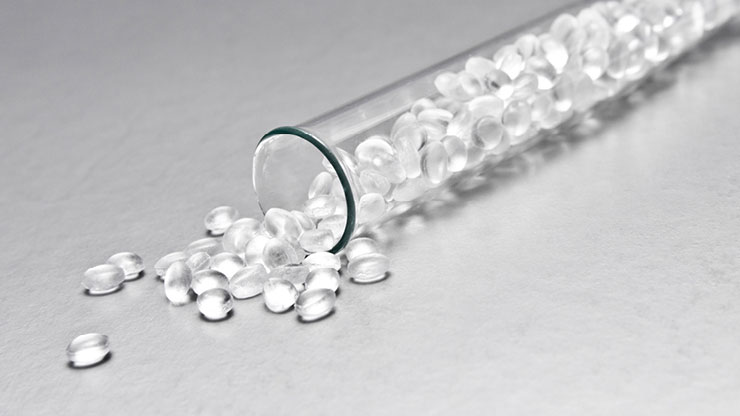
SEPTON™ BIO-series (bio-based TPE)
With SEPTON™ BIO-series, Kuraray offers a unique hydrogenated styrene farnesene block copolymer (HSFC) – which makes Kuraray the first and only manufacturer of bio-based HSBC materials on the market. SEPTON™ BIO-series thermoplastic elastomer represents a new solution for manufacturers that enables new compounds and end-uses with a high bio-based content to expand existing market areas and open up new ones.
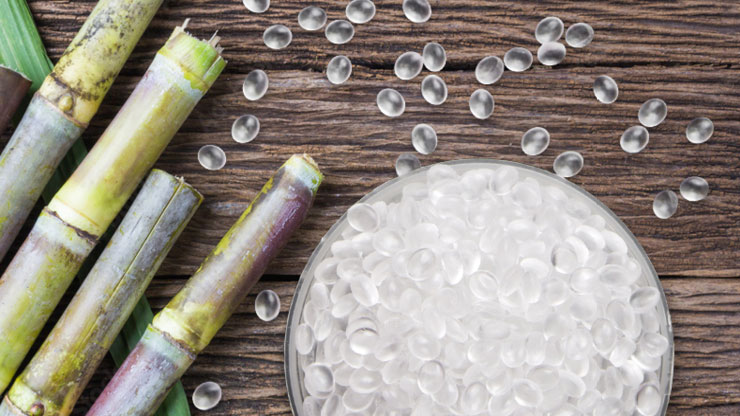
HYBRAR™ (SBC/HSBC)
HYBRAR™ is a truly unique triblock copolymer consisting of polystyrene end blocks and a vinyl bonded rich poly-diene mid-block. Due to its peak tan delta near room temperature, HYBRAR™ exhibits high vibration damping and shock absorption properties – even without integrated plasticizer. These TPEs are available as durable hydrogenated and non-hydrogenated grades.

Contact


